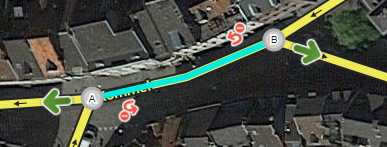(Marked this version for translation) |
https://www.wazebelgium.be/wiki/>UE5F2B5E1 mNo edit summary |
||
| Line 1: | Line 1: | ||
{{TopLine}} | {{TopLine}} | ||
<languages /><translate> | <languages /> | ||
<translate> | |||
==U-turn== <!--T:1--> | ==U-turn== <!--T:1--> | ||
[[File:U-turn-example.png|right | [[File:U-turn-example.png|right]] | ||
Two-way segments will also show the small U-turn arrow icon at both ends of the segment. This is used, as its name suggests, to prevent/enable Waze to use a segment end node as a U-turn, in case of necessity. <br /> | Two-way segments will also show the small U-turn arrow icon at both ends of the segment. This is used, as its name suggests, to prevent/enable Waze to use a segment end node as a U-turn, in case of necessity. <br /> | ||
<br /> | <br /> | ||
The standard rule in the | The standard rule in the BeLux: U-turns should be disabled: [[File:Wme u-turn restricted.png]].<br /> | ||
<br /> | <br /> | ||
===U-turns explained=== | ===U-turns explained=== | ||
[[File: | [[File:Wme u-turn allowed.png|left]] A curved green arrow indicates that a u-turn is allowed in the manner and direction indicated by the arrow at that end of the segment.<br /> | ||
<br /> | <br /> | ||
[[File:Wme u-turn allowed hover clock.png]] When you hover the mouse over an allowed u-turn arrow, a small clock icon appears, which, when clicked on, allowed you to set scheduled u-turn restrictions, as well as vehicle type restrictions on the U-turn.<br /> | [[File:Wme u-turn allowed hover clock.png|left]] When you hover the mouse over an allowed u-turn arrow, a small clock icon appears, which, when clicked on, allowed you to set scheduled u-turn restrictions, as well as vehicle type restrictions on the U-turn.<br /> | ||
<br /> | <br /> | ||
[[File: | [[File:Wme u-turn restricted.png|left]] A curved red arrow with the slashed-circle icon indicates that a u-turn is not allowed (is restricted) in the manner and direction indicated by the arrow at that end of the segment.<br /> | ||
<br /> | <br /> | ||
[[File: | [[File:Wme u-turn scheduled.png|left]] A curved yellow arrow with a clock icon indicates the presence of scheduled (time-based) turn restrictions for the direction indicated by the arrow at that end of the segment.<br /> | ||
<br /> | <br /> | ||
Revision as of 15:12, 18 January 2020
U-turn

Two-way segments will also show the small U-turn arrow icon at both ends of the segment. This is used, as its name suggests, to prevent/enable Waze to use a segment end node as a U-turn, in case of necessity.
The standard rule in the BeLux: U-turns should be disabled: ![]() .
.
U-turns explained

A curved green arrow indicates that a u-turn is allowed in the manner and direction indicated by the arrow at that end of the segment.

When you hover the mouse over an allowed u-turn arrow, a small clock icon appears, which, when clicked on, allowed you to set scheduled u-turn restrictions, as well as vehicle type restrictions on the U-turn.

A curved red arrow with the slashed-circle icon indicates that a u-turn is not allowed (is restricted) in the manner and direction indicated by the arrow at that end of the segment.

A curved yellow arrow with a clock icon indicates the presence of scheduled (time-based) turn restrictions for the direction indicated by the arrow at that end of the segment.
Remarks
- See for U-turn prevention the Road aspects page paragraph Double left and double right.
